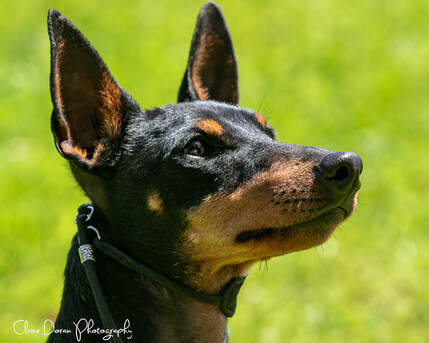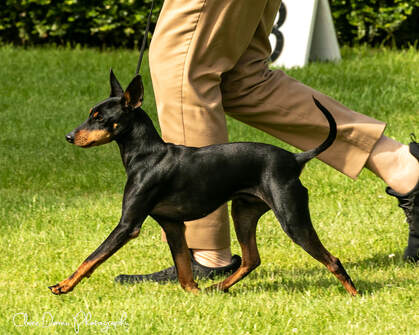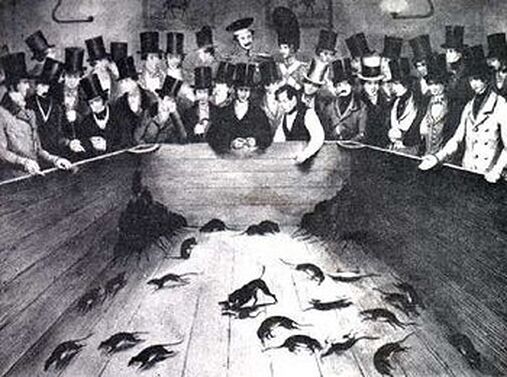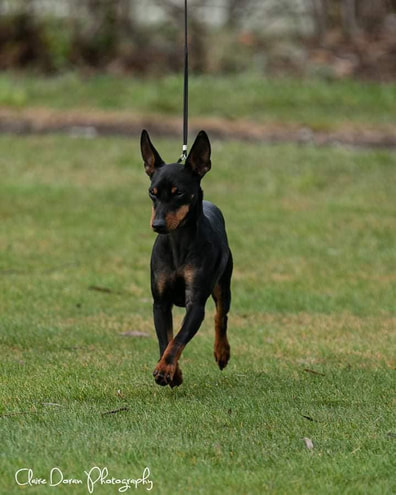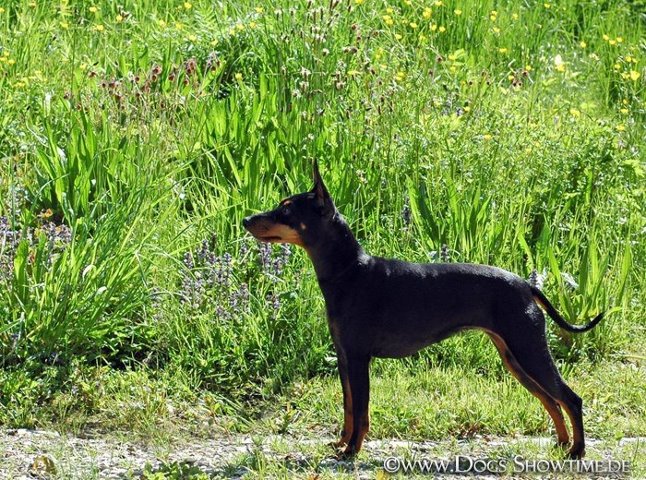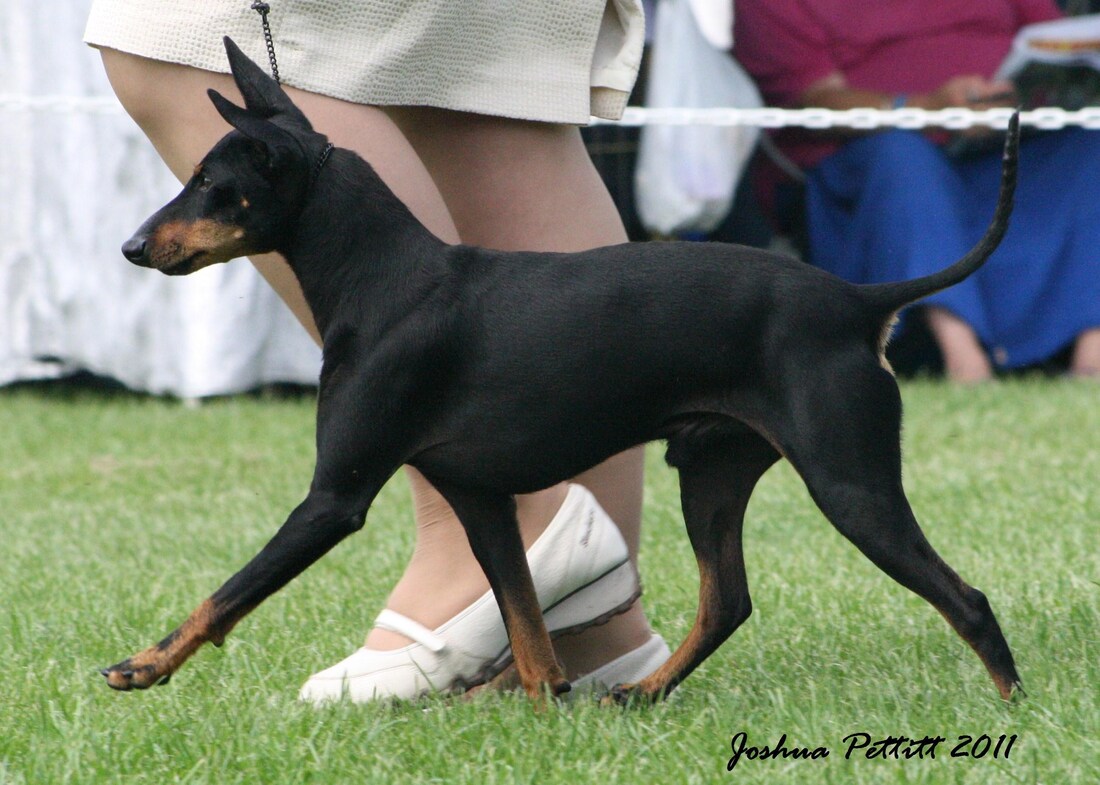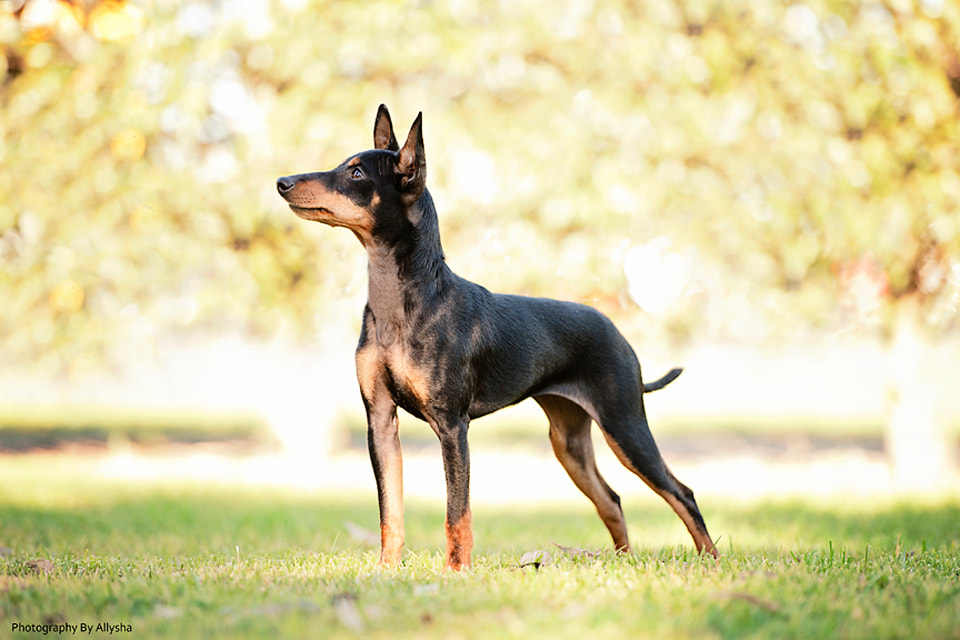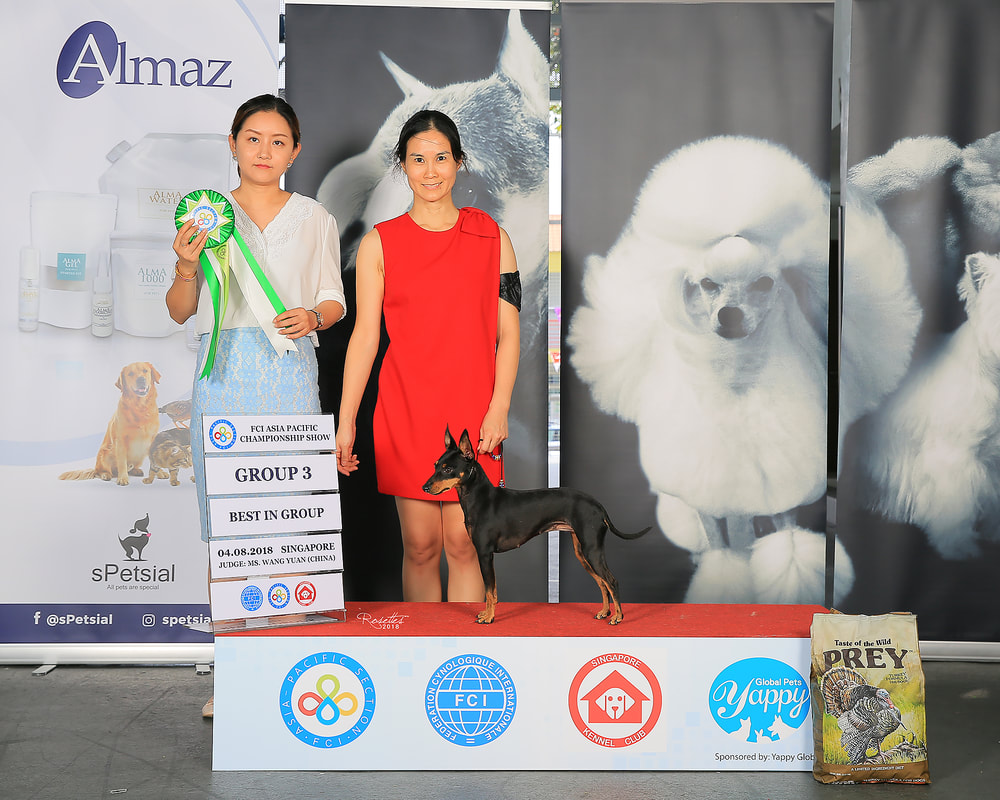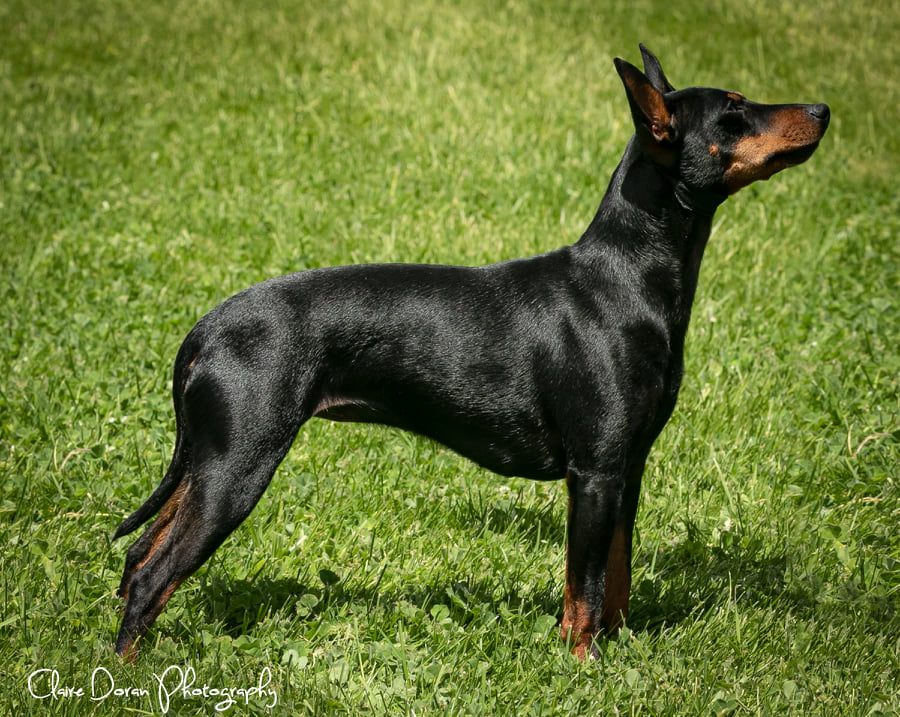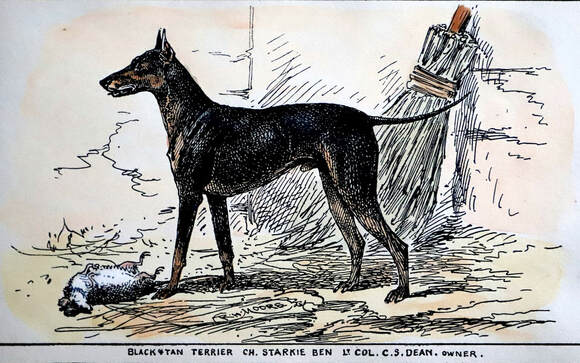Yurrugar English Toy Terrier puppies are born in a whelping box in the home where they can be part of everyday life. Eventually they will have access to outside for playtime in the puppy playground but continue to sleep inside at night. They are exposed to adult ETTs in the home, people coming and going, cats, horses and cattle at the back fence, car rides and so much more. We pride ourselves on producing ETTs that are extremely well adjusted and with the most magnificent temperaments. Our main goal when breeding is to produce beautiful, healthy, world class English Toy Terriers. We will generally keep at least one puppy for showing from every one of our litters, and any that we do not keep (it is not practical for us to keep them all), we proudly offer to the very best of companion homes. Show and breeding prospects are reserved for ourselves and international enthusiasts only. Please do not wait to see puppies advertised as we get many inquiries and puppies are often spoken for before birth. Available puppies will be offered to those who have made past inquiries. NOTE: An English Toy Terrier from any reputable breeder will usually cost upwards of $3500AUD, so please be aware of this before you start making your inquiries.
Yurrugar English Toy Terriers are members of Dogs Victoria. What is the difference between a “Registered Breeder” and a “Registered Breeder with Dogs Victoria”? A person may advertise as a “Registered Breeder” but this does not mean that they are a member of Dogs Victoria (or their own ANKC state member body) as they may be registered with their local council as a Domestic Animal Business. Being a member of Dogs Victoria, we are bound to rules, regulations & a code of ethics in regards to breeding, must register puppies bred by us, and can only breed a recognised breed with the Australian National Kennel Council. The ANKC are also the only Australian organisation whose dog showing exhibitions are recognised worldwide by other country canine controlling bodies. Please visit the Dogs Victoria website, listed at the bottom of our contact page, for further information about them and their mission. Our Dogs Victoria and PER Source/Animal Welfare Victoria breeder numbers, as well as genetic and health testing of our breeding dogs, are available to our new puppy owners once a relationship has been established. We have many happy owners of our dogs that are willing to give us references if you require.
"The ETT has a good deal of the typical terrier personality: courageous, effervescent and more than capable of giving any number of rats or mice a nasty surprise. While he is never aggressive, the ETT is not one to make friends indiscriminately. He is an admirable watchdog as he is always alert to what is happening and has extremely keen hearing. He does not bark for no reason, contrary to what some may believe. He is good with children but is unlikely to be patient with teasing or clumsy handling, so he is best suited to families with older, more considerate children. He can be quite sociable with other dogs, but care must be taken with small domestic pets as scurrying movements will trigger his ratting instinct. Gardens need to be well fenced as the ETT is an inquisitive chap with an independent streak and his curiosity and self-confidence may lead him to stray into trouble. The English Toy Terrier is at home in city or country, apartment or farm, wherever his owner is that is where he finds comfort and contentment." Credit, Dogsey.com
English Toy Terrier (B&T) official, ANKC, breed standard...
|
General Appearance
Well balanced, elegant and compact, sleek and cleanly built. Characteristics Toy with Terrier characteristics. Temperament Alert, remembering that historically he could acquit himself satisfactorily in the rat pit. Never unduly nervous. Head and Skull Head long, narrow, flat skull, wedge-shaped without emphasis of cheek muscles, well filled up under eyes. Top and bottom jaws held tightly together within compressed lips. Slight stop. Fore face tapers gently to provide wedge-shaped impression, in profile similar to that seen when viewed from front. Although an illusion of being overshot can result, any suggestion of snipey appearance is undesirable. Nose black. Eyes Dark to black, without light shading from iris. Relatively small, almond shaped, obliquely set and sparkling, not prominent. Ears Candle-flame shape, slightly pointed tips, placed high upon back of skull and proportionately close together. A guide to size can be obtained by bending ear forward – it should not reach eye. From nine months of age ear carriage must be erect. Entire inside of ear should face front. Leather of ear thin. Mouth Jaws strong, with a perfect, regular and complete scissor bite, i.e. upper teeth closely overlapping lower teeth and set square to the jaws. Teeth level and strong. Neck Long, graceful, slightly arched. Shoulders well laid back. Line of neck flowing into shoulders, and sloping off elegantly. Throatiness undesirable. Forequarters Legs falling straight from shoulders with elbows close to chest providing a straight front. Fine bone eminently desirable. Body Body compact, head and legs proportionate thus producing correct balance. Back very slightly curving from behind shoulder to loin, falling again to root of tail. Chest narrow and deep with ribs well sprung. Loins well cut up. Buttocks gently rounded. Hindquarters Well rounded loin leading to a good turn of stifle; hocks well let down; turning neither in nor out; a ‘tucked under’ appearance undesirable. Feet Dainty, compact; split up between toes; well arched, with jet black nails, two middle toes of front feet rather longer than others, hind feet cat-like. Hare feet undesirable. Tail Thick at root, tapering to point. Set low and not reaching below hock. ‘Gay’ tail undesirable if displayed to excess. Gait/Movement Ideal fore-movement akin to the ‘extended trot’; hackney action not desirable; equally a ‘shuffling gait’ undesirable. Hind action smooth with ease and precision combined with drive, there should be flowing quality to indicate true soundness. Coat Thick, close and glossy. A density of short hair required. Colour Black and Tan. The black ebony, the tan likened to a new chestnut deeply rich. Colours not running or blending into each other, but meeting abruptly, forming clear and well defined lines of colour division. Forelegs tanned to knees in front. The tan then continuing inside and at back of forelegs to point just below elbows, the thin black line up each toe (pencilling) and a clearly defined black mark (thumb mark) on centre of each pastern, and under chin. Hindlegs well tanned in front and inside with black bar dividing tan at centre of lower thigh. Heavy tan on outside of hindquarters (breeching) undesirable. Muzzle well tanned. Nose black, the black continuing along top of muzzle, curving below eyes to base of throat. A tan spot above each eye and a small tan spot on each cheek. Under-jaw and throat tanned, lip line black. Hair inside ears tan (tan behind ears undesirable). Each side of chest has some tan. Vent and under root of tail, tan. White hairs forming a patch anywhere totally undesirable. Size Ideal weight 2.7-3.6 kgs (6-8 lbs). Ideal height 25-30 cms (10-12 ins) at the shoulder. Faults Any departure from the foregoing points should be considered a fault and the seriousness with which the fault should be regarded should be in exact proportion to its degree and its effect upon the health and welfare of the dog. Note Male animals should have two apparently normal testicles fully descended into the scrotum. |
Brief Breed History...
Formally known as the Black and Tan Terrier, the English Toy Terrier (Black & Tan), ETT has possibly been around since the 1500’s.
The English Toy Terrier came into existence as a vermin hunter and formidable adversary in the rat pit. Its distant forebears were the smooth Black and Tan Terriers which have a documented history going back to the 16th century. From the Black and Tans came the Manchester Terriers and from small specimens of this breed the English Toy Terrier was developed. During the Victorian era tiny dogs were much admired with the consequence that English Toys were bred smaller and smaller to satisfy the demands of the fashionable. Breeding for size without thought of health and temperament did the breed a great disservice, but fortunately that trend was reversed and English Toys are again the robust and sensible dogs they should always have been.
Breed Character...
The ETT has a good deal of the typical terrier personality: courageous, effervescent and more than capable of giving any number of rats or mice a nasty surprise.
While he is never aggressive the ETT is not one to make friends indiscriminately. He is an admirable watchdog as he is always alert to what is happening and has extremely keen hearing. He is good with children but is unlikely to be patient with teasing or clumsy handling, so he is best suited to families with older, more considerate children. He can be quite sociable with other dogs, but care must be taken with small domestic pets as scurrying movements will trigger his ratting instinct. Gardens need to be well fenced as the ETT is an inquisitive chap with an independent streak and his curiosity and self-confidence may lead him to stray into trouble. The English Toy Terrier is at home in city or country, apartment or farm, wherever his owner is that is where he finds comfort and contentment. Images this page credited to Yurrugar English Toy Terriers and the UK ETT Club.
|
Note for prospective puppy buyers. Size – The Kennel Club (UK) breed standard, and subsequent ANKC breed standard, is a guide and description of the ideal for the breed; the size as described does not imply that a dog will match the measurements given (height or weight). A dog might be larger or smaller than the size measurements stated in the breed standard.
|
